Introduction: The Marketplace of Flesh Has Gone Digital
In the year 2049, the internet looks nothing like it did two decades ago. Social networks are obsolete, replaced by immersive, AI-managed metaverses where reality itself is optional. Beneath this shimmering veil of simulated bliss lies iofbodies.com, a chilling evolution of e-commerce — not for clothes, shoes, or gadgets, but for bodies. Yes, bodies.
A black-glass homepage greets you with the slogan:
“Don’t rent your identity. Own a better one.”
It reads like a clever marketing hook, but what lies beneath is a techno-dystopian mirror reflecting the blurred lines between consciousness, identity, and commodified humanity. This speculative site, iofbodies.com, operates at the intersection of digital identity, AI-driven body swapping, and a ruthless post-human marketplace.
Chapter 1: The Death of the Original Self
In this imagined future, biometric security has become a joke. Fingerprints are spoofed. DNA is duplicated. Facial scans are outdated. What matters now is neuro-tagging—your brain’s unique electrical pattern uploaded and registered on the cloud. It’s the final step in confirming who you are, but with the rise of IOF (Identity Over Flesh) technologies, that boundary has become permeable.
iofbodies.com exploits this. You can now upload your consciousness into the blockchain, and from there, rent, lease, or buy physical avatars that fit your desired aesthetic, social tier, or occupational function. Want to live as a genetically enhanced athlete? There’s a body package for that. Crave the aura of a celebrity influencer? Bid high enough and you can license their cloned shell — if their legal estate allows it.
The tragedy? Once you swap, your old body goes up for auction unless you’ve purchased an Identity Retention License (IRL). It’s post-human commerce at its most cold-blooded: the sale of your skin, bones, and everything that once tethered you to “you.”
Chapter 2: Body Swapping AI – Powered by Empathy Engines
Behind the seamless swaps is a revolutionary system called the Empathy Engine — an AI trained on petabytes of human behavioral data scraped from centuries of social media, surveillance, and digital records. It doesn’t just map your personality into a new body; it optimizes it.
Want to be funnier? Smarter? Better looking and more persuasive? The Empathy Engine rewrites microexpressions, alters voice modulation, and even rewires your laugh to mimic that of a beloved public figure. With each swap, you’re not just changing your appearance — you’re evolving into a hyper-optimized version of humanity.
This tech makes deepfake videos look like cave paintings. Reality becomes fluid. And the black market? It’s thriving. Celebrities who died decades ago are back — not in CGI films, but walking the streets, reincarnated by AI and worn like luxury brands. The rich don’t age anymore. They just switch skins.
Chapter 3: Digital Identity as Currency
Within the walls of iofbodies.com, digital identity is no longer a personal trait — it’s currency.
User profiles are ranked not by likes or followers, but by cognitive market value (CMV), a proprietary metric combining mental agility, emotional influence, memory integrity, and social desirability. Your CMV determines how desirable your neural imprint is to buyers.
People with high CMVs license fragments of their mind to corporations. Imagine being paid royalties every time a sales AI uses your voice to close a deal. Or leasing your empathy quotient to a virtual therapist that serves 10,000 patients per hour.
Identity becomes fractional. A single person might exist in hundreds of applications, living countless parallel lives — some as lovers, others as laborers, a few as assassins. IOFBodies becomes the stock exchange of souls, with consciousness sold, traded, and rebundled like mortgage loans once were.
Chapter 4: The Ethics of Disembodied Commerce
Societies fractured quickly. Religions splintered. Courts floundered. What constitutes “murder” when the victim is a backup copy? Who owns the rights to a body once it’s left on the open market? What if your old self commits a crime using your face?
Activist groups like ‘Flesh & Code’ began protesting outside IOFBodies data centers, claiming the company commodifies sentience. Their leader, an ex-cyberneticist named Leika Novar, went viral for declaring,
But the corporations shrugged. Ethics are bad for business. And besides, most users clicked “Accept All” without reading the terms — same as they always had.
Chapter 5: The Rise of the Post-Human Aristocracy
Not everyone could afford body-swapping. The elite built identity portfolios — owning dozens of bodies and renting them out like Airbnbs for consciousness. The ultra-wealthy no longer fought for generational wealth; they became generational identities, their minds encoded to hop across centuries, leaping from one custom-built vessel to the next.
On the other end? The Unmapped. People without the resources to upload, stuck in decaying biological forms. They were called “Skins”—living relics of the old world, increasingly ostracized in a world obsessed with optimization.
The digital caste system was complete:
- Ghosts (free-roaming AIs based on real people)
- Blanks (bodies-for-hire)
- Skins (original humans)
- Anchors (multi-body consciousness owners)
At the center sat iofbodies.com, the indifferent god of this identity-driven dystopia, processing trades like any other cold, efficient marketplace.
Conclusion: Echoes of Now in Tomorrow’s Flesh
While the story of iofbodies.com is speculative, it’s built on the scaffolding of existing technology: biometric data, neural interfaces, identity commodification, AI-driven personality analysis, and the growing trend of digital embodiment. Already, startups are exploring mind-uploading, AI-generated influencers, and metaverse avatars that reflect our ideal selves more than our real ones.
So perhaps the question isn’t if iofbodies.com could exist — it’s whether we’d recognize the signs before it arrives.


